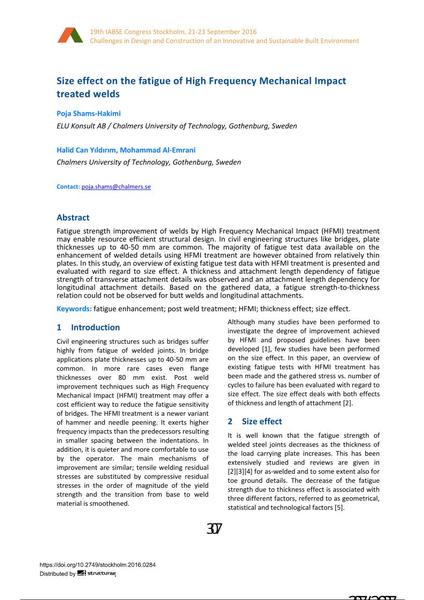Size effect on the fatigue of High Frequency Mechanical Impact treated welds

|
|
|||||||||||
Détails bibliographiques
| Auteur(s): |
Poja Shams-Hakimi
(ELU Konsult AB / Chalmers University of Technology, Gothenburg, Sweden)
Halid Can Yıldırım (Chalmers University of Technology, Gothenburg, Sweden) Mohammad Al-Emrani (Chalmers University of Technology, Gothenburg, Sweden) |
||||
|---|---|---|---|---|---|
| Médium: | papier de conférence | ||||
| Langue(s): | anglais | ||||
| Conférence: | IABSE Congress: Challenges in Design and Construction of an Innovative and Sustainable Built Environment, Stockholm, Sweden, 21-23 September 2016 | ||||
| Publié dans: | IABSE Congress Stockholm, 2016 | ||||
|
|||||
| Page(s): | 307-314 | ||||
| Nombre total de pages (du PDF): | 8 | ||||
| Année: | 2016 | ||||
| DOI: | 10.2749/stockholm.2016.0284 | ||||
| Abstrait: |
Fatigue strength improvement of welds by High Frequency Mechanical Impact (HFMI) treatment may enable resource efficient structural design. In civil engineering structures like bridges, plate thicknesses up to 40-50 mm are common. The majority of fatigue test data available on the enhancement of welded details using HFMI treatment are however obtained from relatively thin plates. In this study, an overview of existing fatigue test data with HFMI treatment is presented and evaluated with regard to size effect. A thickness and attachment length dependency of fatigue strength of transverse attachment details was observed and an attachment length dependency for longitudinal attachment details. Based on the gathered data, a fatigue strength-to-thickness relation could not be observed for butt welds and longitudinal attachments. |
||||
